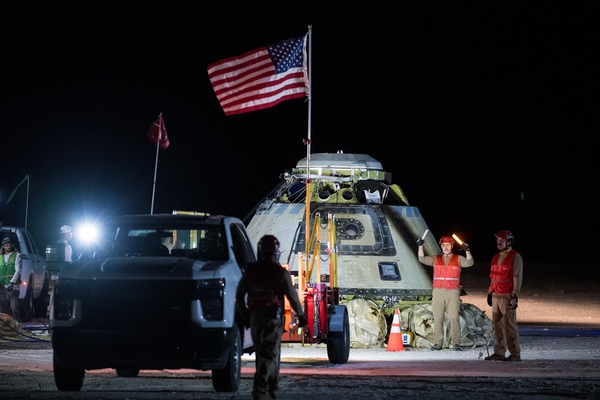NASA and safety: more is betterby Roger Handberg
|
| NASA might not survive another disaster involving crew loss and NASA had an option apparently safer than a Starliner return flight. |
Two factors now led to a choice maximizing crew safety. One is simply institutional survival. NASA might not survive another disaster involving crew loss and NASA had an option apparently safer than a Starliner return flight. Having this second, safer flight option vindicated the US Air Force resistance decades ago to designating the Space Shuttle as the sole American flag space carrier. The Air Force resisted what they perceived as NASA dominance, but part of their resistance was the specter of a single-point-failure launch profile. Tragically, the 1986 Challenger launch failure drove their point home. After more than two years, NASA’s return to flight was successful. Having the shuttle solo option removed, the Air Force restarted their ELV flight program. That effort also encountered difficulties with flight failures, but no personnel died.
NASA, in developing the Commercial Crew Program, actively encouraged and funded the program to produce several flight options. The goal was to have a backup if one flight option encountered issues, possibly disrupting service. Ideally, the result is a continuous ability to conduct flight options. The difficulty becomes if the second option encounters difficulties disrupting operations. That occurred briefly this summer when SpaceX suffered two flight anomalies. The first involved a leak in an upper stage of the Falcon 9 that prevented the Starlink spacecraft on board from reaching their proper orbit. That grounded the Falcon 9 for about two weeks in July. The second accident occurred in late August when a booster broke up while descending on its landing barge, halting launches for two days. The delay imposed by the FAA was short in both instances, the latter incident occurred during booster recovery rather than during launch. The FAA was acting based on an evaluation that SpaceX Falcon 9 rockets had a long run of successful launches with only minimal disruption.
Regardless, the situation reinforces the need for alternative launch options. In fact, alternative launch options for payloads exist both domestically and internationally, but what is less available are human passenger carriers, with the Chinese and Russians being the only currently available flight options. For a few reasons, neither is likely to be acceptable to American politicians having just lifted the yoke of Russia as the sole American way to the International Space Station. Other international options are developmental: India or, much later, Europe or possibly Japan. Domestically, Dream Chaser and Blue Origin were earlier competitors who NASA encouraged to continue but did not fund. Both need to demonstrate a capacity to launch successfully then move forward to launching crews. Real consistent development of human access to orbit and beyond demands more than one or two flight options.
For reasons of cost and redundancy, even a two-flight option is suboptimal but at least somewhat of an improvement. Losing one flight option leaves NASA and the commercial human spaceflight market dependent on a single option. The costs may not decrease because the incumbent has no incentive to reduce prices. The longer the delay in developing a second option or a third option means greater incentives for other states to push expansion of their independent options. American prominence in space matters is based on its technological edge, one that is eroding. The world grows more skilled and sophisticated regarding space operations, reducing the American margin of difference.
| NASA may need to become reengaged in the pursuit of additional human spaceflight options, not because it wants to do, but because it must if the United States is remain competitive globally and in the future. |
NASA must encourage alternatives beyond the two designated flight options. This might involve some funding to possible new entrants. The unknown is always difficult especially when NASA wants to focus on deep space operations, moving out of low Earth orbit. Necessity forces NASA to reengage in developing other human spaceflight options. Most interesting is the NASA response given administrator Bill Nelson’s earlier astronaut experience just before the Challenger accident; safety was always his first instinct. Nelson is not considered a “real” astronaut given the political nature of his flight but it does appear to impact him as if he were such an individual. In fact, his perspective might be even more safety focused since he was not chosen from those considered to have the “right stuff.”
That focus on safety is not a unique view but often neglected due to the pressure of events and concerns for organizational survival. There was active disagreement over the flyback decision based on technical issues but also institutional factors. Boeing is in a difficult position to argue that the crew should come back with the Starliner, but to not do so places Boeing in a position where its efforts to this point are signaling disaster for its long-term space activities. If this flight is not designated as a completed mission certifying the Starliner, the cost that Boeing incurs may be sufficient for it to exit the field. This did not occur in a vacuum for Boeing as it is an organization under stress.
For that reason, NASA decisions here appear more reasonable at the time. The successful return of the Starliner does not change the original calculation especially given that one thruster failed but was not fatal to the return flight. Regardless, NASA may need to become reengaged in the pursuit of additional human spaceflight options, not because it wants to do, but because it must if the United States is remain competitive globally and in the future.
Note: we are now moderating comments. There will be a delay in posting comments and no guarantee that all submitted comments will be posted.
